There's a lot to learn when it comes to elimination communication (EC), and it can be overwhelming. The hardest part is starting and I've got the easiest way for you to begin today!
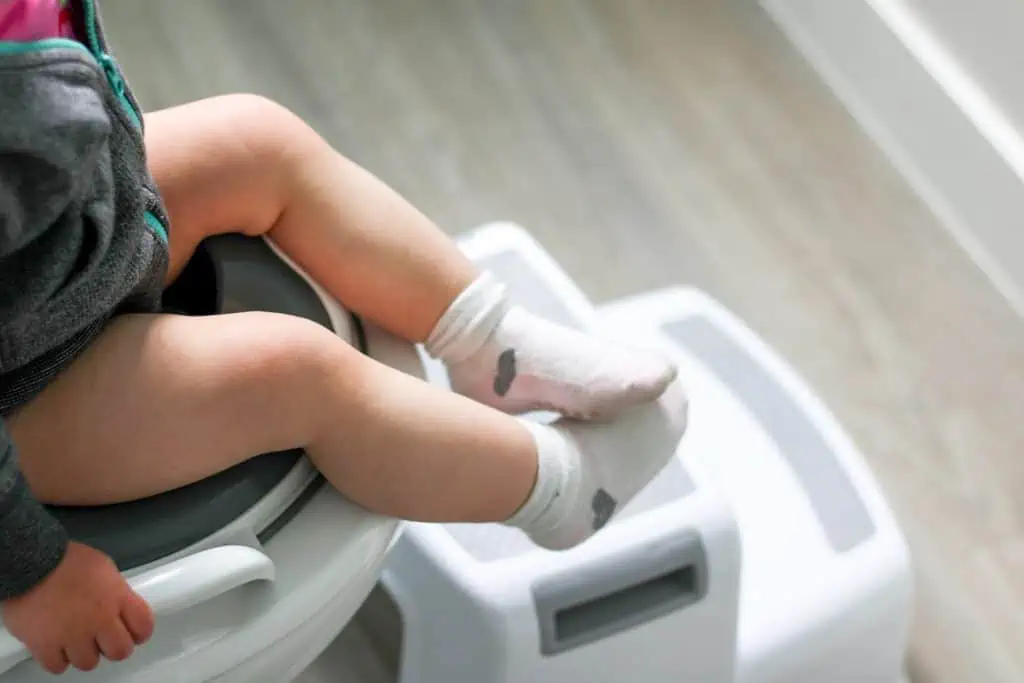
Before I ever had a baby, I heard about elimination communication- a method for early toilet training. I was shocked and amazed that it was a thing, but it's actually been the norm for most of human existence. Only recently have we become dependent on diapers and children are being potty trained later and later. (P.S. Cloth diapers are a great companion to EC- find out how to start with cloth diapers!)
There is a lot of information out there about different ways to do elimination communication. In this post, I'm going to narrow it down to the simplest, easiest way to start, so you don't get overwhelmed. This is the way I started and it turned out to be very easy and manageable.
What's Elimination Communication?
Think about mammals and their natural tendencies when it comes to hygiene. Do they soil their sleeping places, their family or themselves? No! Many mammals relieve themselves in the same spot. Why would human babies not have those same instincts and tendencies? Well, they do! Elimination communication is the way to learn how your baby communicates their need to go and the natural times they need to go and you responding by giving them a place to go so they don't soil themselves. This can be done from the day your baby is born! If you are consistent with your EC efforts, this leads naturally to toilet training well before the age of 2. It's truly amazing!
I have learned all about it from the EC guru, Andrea Olson, author of "Go Diaper Free" and host of the "The Go Diaper Free podcast". She has ALL the expertise when it comes to learning to implement EC and stop relying on diapers!! To dive deeper with Andrea into what EC is about, visit this page, and I highly encourage you to get her book and listen to her podcast! (Not sponsored, I am just truly thankful for all I have learned from her.)
Is Elimination Communication Harmful?
No! Many people say it can be harmful to try to potty train too early, and this can be true, depending on the method you are using. Elimination communication is gentle potty training. There is no coercion or force used. There are thousands and thousands around the world that use this method, not to mention most of the human race before the introduction of diapers in the 1950's. In fact, EC has many benefits, including physical, emotional and developmental.
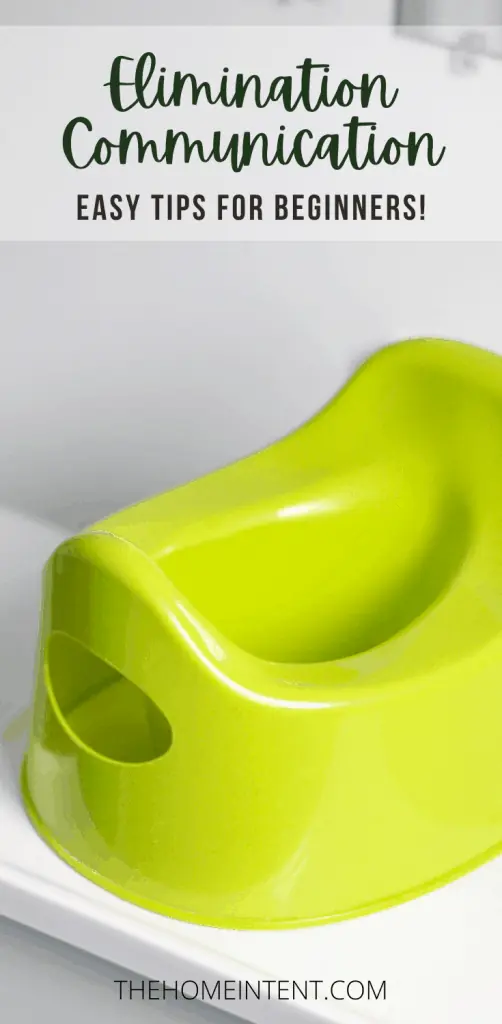
Why Do Elimination Communication?
Physical Benefits
Most parents who practice EC, use a diaper (whether cloth or disposable) as a "back-up". Because of more frequent pottying, the baby doesn't usually go long periods of time with a wet or poopy diaper, which is much more beneficial for the skin.
Disposable diapers are FILLED with nasty chemicals. Doing EC will reduce the amount of time you need to use diapers, so if you use disposable, this will reduce your baby's exposure to those chemicals.
Emotional Benefits
Because you are figuring out how your baby communicates to you, an even deeper connection is formed between you two! Your baby communicates, you respond, their needs are met and their trust in you as a dependable, loving parent increases.
Developmental Benefits
When EC is done from a young age, baby is used to sitting on the toilet and relieving themselves, there is never a shocking adjustment. Think about the 4-year-old who has become accustomed to going in his diaper for years, since that's just what you do, all of a sudden is being told that he shouldn't go in his diaper and needs to go somewhere else. How confusing is that? No wonder they have such a hard time.
The practice of EC encourages the development of self-confidence and independence from a younger age.
More Benefits
You'll use fewer diapers, which means less waste and more money in your pocket. (Find my favorite cloth diaper covers here and here!)
Clean up is much easier when your baby goes in the toilet rather than the diaper.
The potty training process will be SO MUCH EASIER.
EC can help answer questions like, "I have no idea why my baby is fussy right now!". She may just need to eliminate. Or, "My baby has been waking in the middle of the night." Maybe she needs to eliminate.
You will gain confidence in yourself to do what you think is right and best for your baby because it goes against societal norms!
What Age to Start Elimination Communication?
You can start anytime from birth up until about 18 months of age.
How to Hold Baby While Doing EC
When just starting out, especially with a newborn, the best way to hold your baby over your chosen receptacle is the "classic" EC hold. Your baby's back is against your front, so they are facing away from you. You hold their thighs with your hands. I demonstrated in the photo below with a teddy bear as the baby. (My daughter is too old and wouldn't hold still in this pose!)
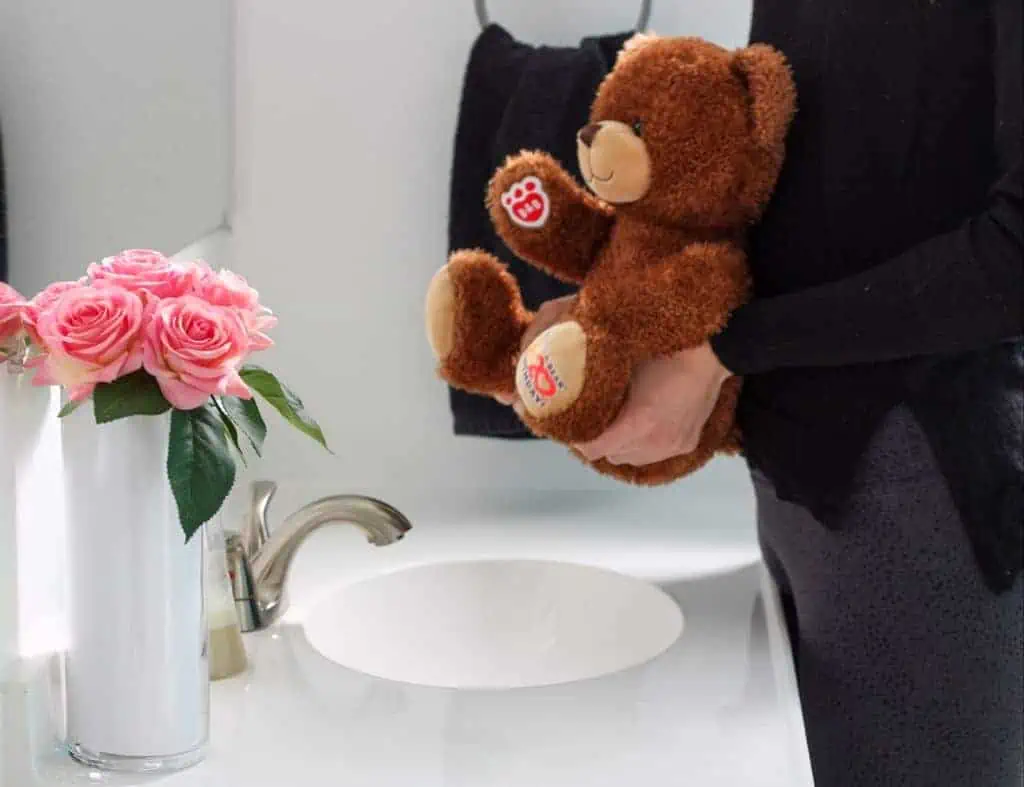
You can also hold your baby under the armpits while they sit on their tiny potty, either facing you or facing away, as shown below. I found these were the easiest ways to do it.
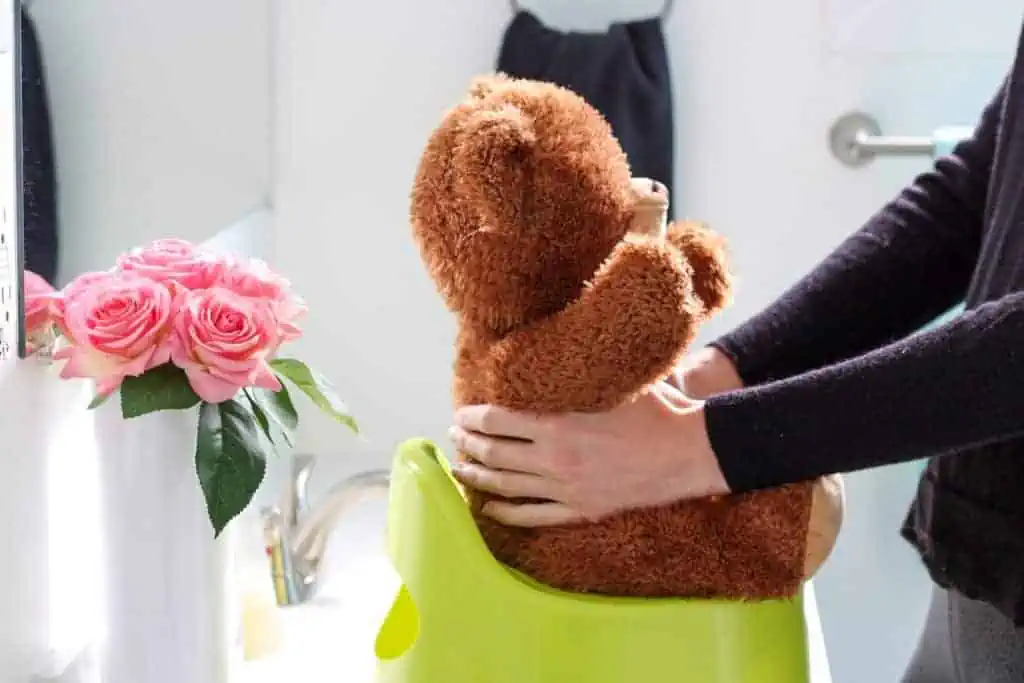
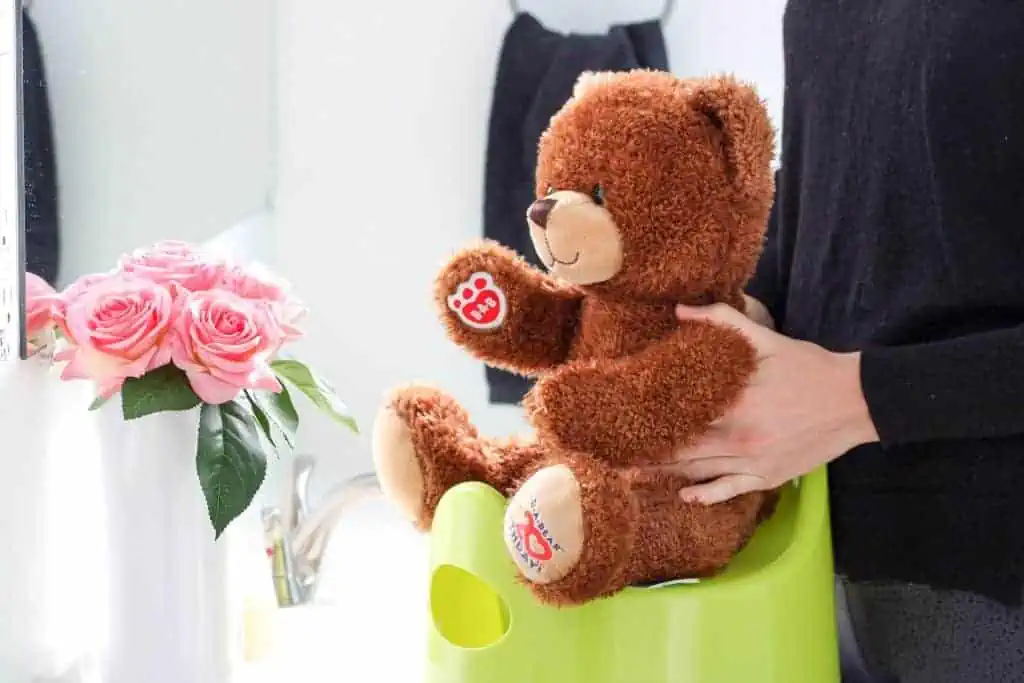
How to Start Elimination Communication
This is how I did it and it was the easiest way to start. I was taught that the key to success is consistency. You could even just choose one time to offer the potty and as long as you are consistent, it will still have positive effects!
What Do You Need to Start Elimination Communication?
Really, nothing! You can potty your baby right over the toilet or sink. When we started, I literally went to the dollar store and bought a bucket (like the kind for playing in the sand and making sandcastles). We used that for a while using the classic EC hold and then when I was at Ikea, I saw their little green potty that was $3.99 and knew that would be a great next step. We started using it once baby could sit on her own. Down the road, when baby starts to stand up and run away from the potty, a great solution is a toilet seat reducer for the toilet.
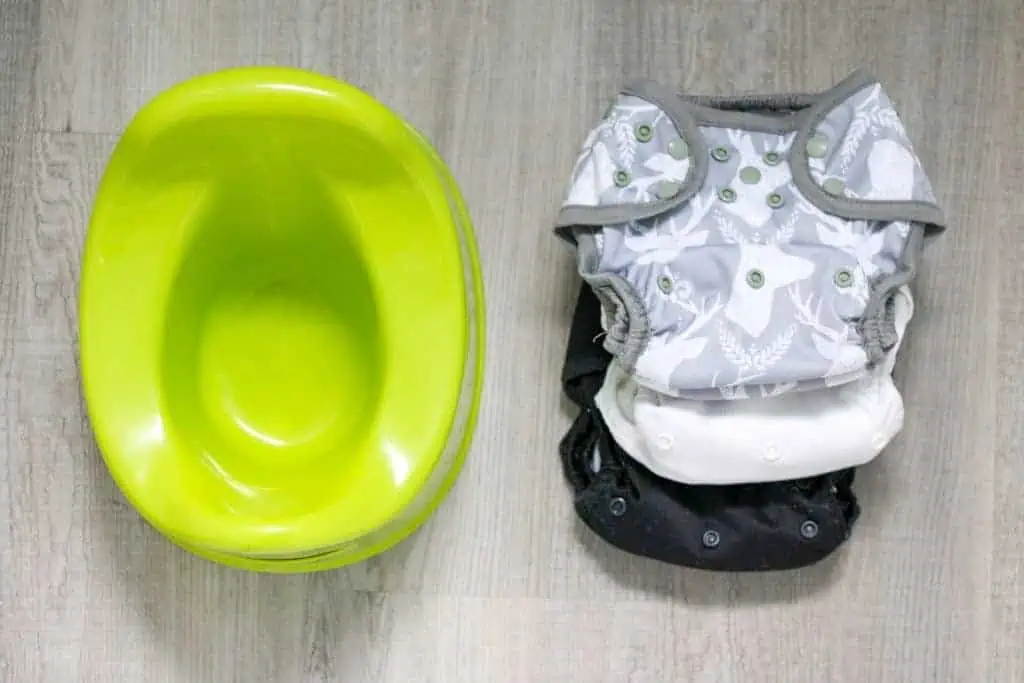
Observation Time
Andrea highly recommends observing your baby to figure out their signals and cues to you that they need to go! I did this for 2 days and really couldn't figure out any signals (apparently some babies don't give signals, or they are super subtle, so can't be detected). There are 4 ways to know baby needs to potty according to Andrea: signals, natural timing (as seen in observation), generic timing (when most babies generally need to go) and intuition. Since generic timing seemed the simplest to me, that's where I started.
When to Offer the Potty
- Immediately after baby wakes up (whether in the morning or after a nap)
- At EVERY diaper change. (This sounds like a lot, but believe me, it only takes an extra minute or two and it will save you a ton of cleanup.)
- Whenever it's clear that baby is starting to poop. (You know the face and the sounds!)
Tips
- Make a sound association with peeing or pooping. Ours was "pssss" when she was peeing and a grunting sound when she was pooping. Even at this early age, baby can learn to associate the sound with what she is doing and eventually make the sound to tell you she needs to go!
- Have a disposable or cloth wipe out and ready so after she goes, you can give her a quick wipe before putting her down. This way, you won't dirty the surface you are changing her on.
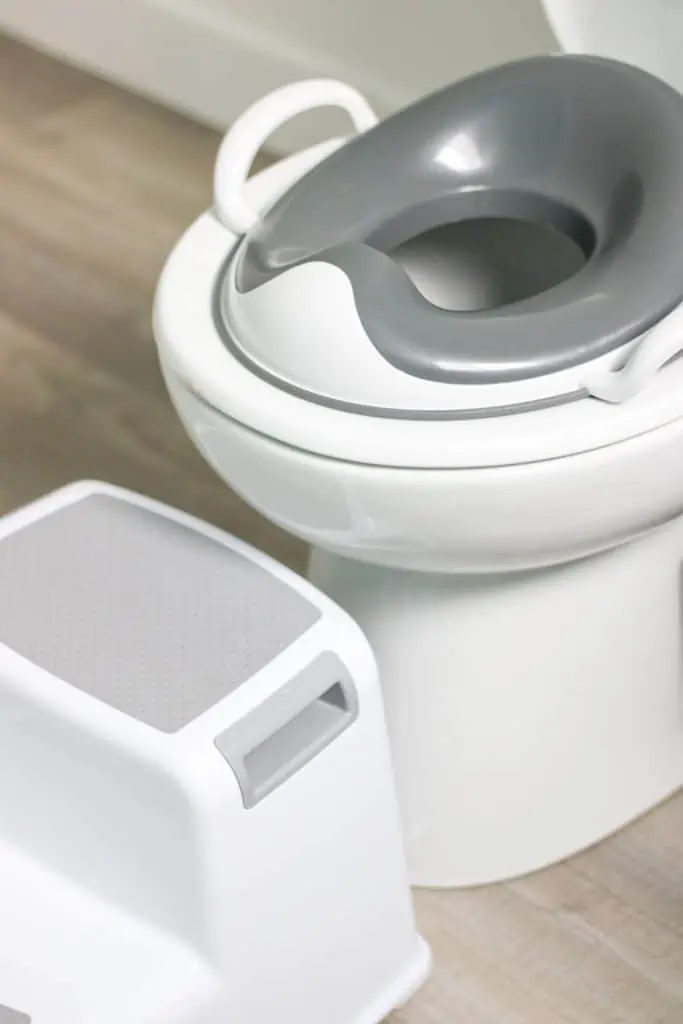
Taking the Next Steps
I again recommend using Andrea Olson's resources on her website to figure out your next steps. For us, we did the above-mentioned and added on offering the potty before and after transition times (eg. putting her in the high chair, taking out of the car seat, etc). We were doing the "4 easy catches" that Andrea states are at wake up, when pooping, at diaper change time and transition times.
As I stated before, if your baby starts to stand up from sitting on the little potty, it's likely time to transition to the big toilet with a toilet seat reducer. It's also great to have a step stool, so baby can practice climbing up to the toilet and pulling down their pants. Andrea also points out it's important not to hover over your child when they are eliminating, so be close by, but don't stare at them!
I have been reviewing Andrea's hybrid plan (combined plan using EC and non-coercive potty training methods) for ages 12-18 months, which is a guide to wrap up doing EC and stop using diapers altogether. That's our next step!
Is EC Worth the Work?
At first, EC seems time-consuming and hard. Follow what I did to start, then learn more little by little from the Go Diaper Free resources. I can promise that it is worth it! My daughter is 14 months at this point and by following the steps I described above (which were so easy), we catch about 50% of her pees and 90% of her poops in the toilet. That is serious progress towards our goal of ditching diapers!
Once you start doing it, it just becomes a natural part of your routine. I highly encourage you to start and commit to sticking it out. You will not regret it!
What questions do you have about starting EC? Let me know in the comments below. I would love to try to help!




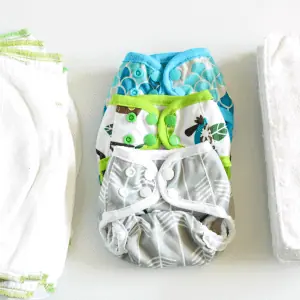

Susan Horner
I wish I had known about this when raising my babies!
thehomeintent
I know! And I wish more people could hear about it now to take advantage of it. It's amazing!
Charity Gallagher
as someone totally knew to EC and in the midst or trying to start, this was invaluable. I've been having real trouble figuring out I'm 2 month old baby's cues and having been feeling pretty overwhelmed. thank you so much for the help. we have a tiny potty coming tomorrow and I'm going to try start with those catches you mentioned above.
Errika
Figuring out the cues was so hard for me too! I'm sure some babies are very subtle about it. But yeah, doing the easy catches is simple enough to do and will be of great benefit!